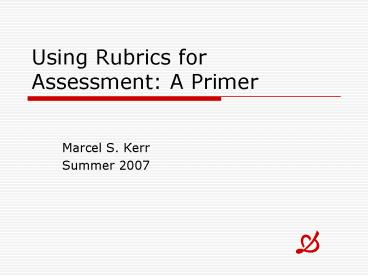Using Rubrics for Assessment: A Primer PowerPoint PPT Presentation
1 / 18
Title: Using Rubrics for Assessment: A Primer
1
Using Rubrics for Assessment A Primer
- Marcel S. Kerr
- Summer 2007
?
2
Presentation Purpose ?
- ? Educate faculty on uses of rubrics
- ? Preparation for General Education Assessment
Plan - Learn to write rubrics for multiple purposes
- Student learning assessment
- Course assessment
- Program assessment
3
Presentation Objectives ?
- Define rubric
- Differentiate types of rubrics
- Identify uses of rubrics
- List advantages of using rubrics
- Construct a rubric
- Determine validity reliability
- End-of-training Quiz
- Complete Rubric Training Rubric
4
What are Rubrics? ?
- A rubric is a scoring scale used to assess
performance along a task-specific set of criteria
rather than a single numeric score. - A means of formative assessment
- Purposes of rubrics
- Describe what outstanding or satisfactory or
inadequate performance looks like - Articulate the criteria against which student
learning is judged - Provide an objective guide for assessment
5
What do Rubrics Assess?
- Assessment level
- Student learning
- Courses
- Programs
- Institutions
- A stated learning objective
- Content the knowledge specific to a given
discipline - Performance skills and internal processes
required for achievement in a given discipline
6
Types of Rubrics ?
- Analytic are more specific easier to apply
break down the objective into dimensions
(criteria) and judge them individually - Used when large number of criteria criteria are
weighted - Holistic are more general assess the entire
objective on one scale - Used for quick or minor assessments open-ended
questions skills
7
Rubric Basic Structure ?
- There are four basic features
- Stated Objective or Purpose - title
- Scoring Criteria characteristics of good
performance on the task - Levels of Performance defined degrees of
competency - Descriptors spell out briefly what is expected
at each level of performance
8
Rubric Basic Structure ?
Objective Research Paper
9
Uses of Rubrics ?
- Set evaluator performer expectations
- Criteria by which work is judged
- Difference between excellent weak work
- Formative student feedback
- Grade assignments
- Standardize grading across graders
- Assess programs (GEC)
10
Rubrics for Program Assessment
?
- Rationale for use
- Faculty created, owned, and operated
- Low cost reusable
- National tests are expensive and problematic
- Natural part of the course or curriculum
- Four General Education Literacy areas
- Language Literacy Written Communication
- Analytic Literacy Problem Solving
- Cultural Literacy Composition of Art
- Social Literacy Personal Civic Responsibility
11
Advantages of Using Rubrics ?
- Clarity
- Expectations, objectives, grading, feedback
- Objectivity
- Standardized, consistent, fair, valid, reliable
- Legitimacy
- Fairness increases student responsibility
- Efficiency
- Easy to make, use and explain
- Improve skills End Products
- Instructor, students, peers
12
Writing Rubrics ?
- Identify and define the assessment objective or
purpose - Select and write the needed number of scoring
criteria - Select and write the desired levels of
performance - If desired, select and write the descriptors
13
Electronic Rubric Builders
- Here are a few
- Teachnology.com
- Rubistar
- Rubric Studio
14
Calibrating Rubrics Validity ?
- Validity the accuracy with which the rubric
assesses the objective or purpose are we
evaluating what we intended? - Self Check
- Colleague Review
- Student Review
- Pilot Test
15
Calibrating Rubrics Reliability ?
- Reliability how consistently the rubric
assesses the objective or purpose over time and
across raters are the resulting scores
consistent? - Interrater consistency of scores assigned by
two or more raters - Intrarater consistency of scores assigned by
same rater at different points in time - External factors time of day, order of
assignments - Internal factors mood, fatigue, attention
16
End-of-training Quiz
- What have we learned?
- Please complete the 10-item online quiz. It is a
quick formative assessment of what weve covered
today. - Upon completion, you will receive a feedback
page with your final score. Please print a copy
of this page and forward it to your Dean or VP as
evidence that you have completed the assessment
training.
17
Rubric Resources
- Documenting Excellence General Education
Rubrics http//www.documentingexcellence.com/exam
ples/rubricgened/rubric.htm - Authentic Assessment Toolbox http//jonathan.muel
ler.faculty.noctrl.edu/toolbox/rubrics.htm - Rubrics.com http//www.rubrics.com/
- Teacher Created Rubrics for Assessment
http//www.uwstout.edu/soe/profdev/rubrics.shtml - Sinclair Community College General Education
Rubrics http//www.sinclair.edu/about/gened/gened
rubrics/index.cfm - CSU Institutional research Assessment
Planning http//www.csufresno.edu/ir/assessment/r
ubric.shtml
18
References
- Moskal, B. M., Leydens, J.A. (2000). Scoring
rubric development Validity and reliability.
Practical Assessment, Research Evaluation,
7(10). Retrieved June 19, 2007 from
http//PAREonline.net/getvn.asp?v7n10 - Practical Assessment, Research and Evaluation. A
Peer-reviewed electronic journal. ISBN 1531-7714.
http//pareonline.net - Richards, K. (2005). A primer on rubrics.
Retrieved, June 15th, 2007 from
http//online.lsc.mnscu.edu/Academics/assessment/D
ocuments/Primer_on_Rubrics.pdf - Stevens, D.D., Levi, A.J. (2004). Introduction
to rubrics An assessment tool to save grading
time, convey effective feedback and promote
student learning. Stylus Publishing.

